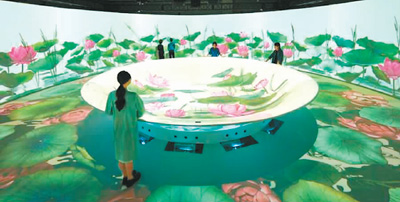Innovation brings Chinese cultural relics back to life for increasingly larger audience
Innovation has made cultural relics come alive and become increasingly integrated with the daily lives of people in multiple ways, providing abundant nourishment for the minds of a wider audience.
Debuting in November 2021, Chinese Archaeology Assembly, a TV program on Chinese archaeological discoveries launched by China Media Group, brought a vast treasure trove of cultural relics across China back to life.

People visit a digital exhibition in Shenzhen, south China’s Guangdong Province, jointly launched by the Palace Museum and Chinese tech giant Tencent. (Photo courtesy of the Palace Museum)
Several experts, scholars, and archaeologists embarked on virtual tours to iconic archaeological sites, unveiling national treasures shrouded in mystery and recounting intriguing stories behind the archaeological discoveries.
The program set up studio scenarios that were strictly based on original, real-world sites and reconstructed the archaeological exploration process, creating an immersive experience for audiences.
The program became a major hit and won praise among numerous people in China. According to statistics, the first episode of the program, which explored the 5,000-year-old Liangzhu culture of the Yangtze River Basin, garnered over 59.85 million TV views after it was aired, becoming one of the hottest topics on social media platform Weibo.
Chen Xingcan, head of the Institute of Archaeology under the Chinese Academy of Social Sciences, said the program, which is different from traditional programs on cultural relics, is more than simply a documentary or a public lecture and instead offers a far more amazing experience.
In addition to Chinese Archaeology Assembly, the second season of The Shape of Culture, a 12-episode reality show that premiered on Zhejiang TV in late December last year, presented UNESCO World Heritage sites in China. In each episode of the show, Shan Jixiang, former curator of the Palace Museum in Beijing, led celebrities to explore a different World Heritage site, joined by other experts and local people alongside.
“The show aims to make cultural relics come alive while introducing them in a relaxed atmosphere,” Shan said, hoping that more and more young people will explore traditional Chinese culture and protect cultural heritage sites.
By venturing to cultural heritage sites to provide immersive and interactive experiences for audiences, the show marks a continuous innovative approach to promoting cultural heritage, said Gao Menghe, a professor of the Department of Cultural Heritage and Museology at Fudan University in Shanghai.
Last year, a slew of new museums with expanded functions opened to the public, offering visitors diversified services and introducing innovative methods to display cultural relics.
At the China Grand Canal Museum in Yangzhou, east China’s Jiangsu Province, visitors can embark on a splendid virtual journey through the ancient Grand Canal. The museum also creates immersive experiences for children, who can explore wetlands along the Grand Canal, and includes an exhibition hall where children can play room escape games themed on the canal.
Museums are not only just depots for storing cultural relics and public educational platforms, according to Huang Yang, an associate professor of Nanjing Normal University in Nanjing, Jiangsu. Huang added that people can also drink coffee or participate in role-playing games in museums, and take home the cultural charm of museums by taking snapshots or buying cultural and creative products.
“To attract visitors, museums highlighted interactive experiences. The aim of using multimedia and new technologies and introducing new forms, including room escape games and role-playing games, is to enrich the experiences of visitors and enable them to better appreciate the value of historical relics and the charm of Chinese culture,” Huang said.
In November 2021, the 22nd meeting of the central committee for deepening overall reform adopted a circular about bringing cultural relics back to life and expanding the international influence of Chinese culture. According to the meeting, China would further integrate cultural relics into people’s lives and enhance Chinese culture’s influence in the international community.
Photos
Related Stories
- Ancient city site discovered in central China
- Cultural relics unearthed from Mausoleum of Han Dynasty emperor
- China's Gansu to exhibit highly-protected cultural relic next year
- Chinese, Italian archaeologists discuss protection of cultural relics
- China issues plan for cultural relic protection, technological innovation
- China sees notable progress in cultural relics protection: report
Copyright © 2022 People's Daily Online. All Rights Reserved.










